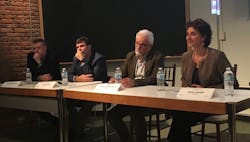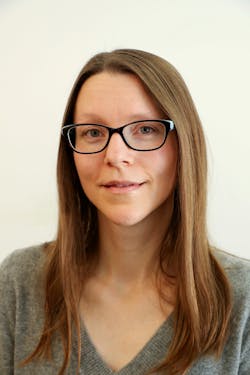From Oct. 15–17, 2019, a group of leaders from industry, academia, and government gathered at the Lighting Research Center (LRC) in Troy, NY for the LRC Summit. The goal of the summit was to inspire discussion and shape the future of lighting, where the industry plays a strategic, recognized role in benefiting society and the environment — from improving human health to enhancing food production to managing clean energy in the new electric grid.
On the first night of the Summit, Dr. Mark Rea offered opening remarks, setting the stage for the entire three-day event. The lighting industry right now is like the movie “Mad Max,” cautioned Rea, and the only way forward is for the insular lighting community to form new collaborations with those outside our limited circle, and to stop “talking to ourselves”; otherwise lighting will become “just a commodity.”
“Today, there are two basic business models for lighting, one trying to serve the existing, well-established lighting standards at the lowest price, and the other trying to leverage existing lighting infrastructure to insert digital communications and artificial intelligence into the built environment,” said Rea. “I believe it is worth considering a third model, one that is less about technology push or cheaply serving existing standards and infrastructure and is more about delivering benefits to society. Value creation for this third business model is still unclear, but one thing does seem clear: If this third business model is to create greater value for society, it cannot do so alone. We must reframe this business model by forming nontraditional partnerships with government agencies, NGOs and academia to collectively advance the effective use of lighting for society and the environment.”
Three pillars
Day 2 of the Summit featured keynote speakers for each of three pillars: Lighting for Healthcare & Humanity, Agricultural Lighting, and Lighting & the Grid.
Dr. Robert White, director of the Regional Newborn Program at Beacon Children’s Hospital and Chair of the Standards Committee for NICU Design, discussed the impact of the physical environment on the wellbeing of patients, families, and caregivers. One important takeaway from his talk was the importance of multidisciplinary leadership in developing standards for NICU Design, which led to significant, tangible improvements to the NICU environment.
Dr. Mariana Figueiro, LRC director, presented select light and health research studies conducted by her team at the LRC. Anyone in the lighting industry is by now well aware that light offers many benefits related to circadian health and wellbeing. Yet many spaces such as schools, offices, and nursing homes are dimly lighted, which can unfortunately lead to negative impacts on health ranging from insomnia to depression to increased risk of certain types of cancer. Figueiro’s research has shown that a specific amount, timing, duration, and distribution of light can significantly improve sleep, mood, and general wellbeing for newborns in the NICU, students in schools, office workers, and older adults, including those living with Alzheimer’s disease. She also presented LRC studies showing how light can reduce depression and fatigue in cancer patients and support alertness in night-shift nurses.
“Tailored lighting, when properly designed to deliver the correct amount of light at the right time, can positively impact health and wellbeing,” said Figueiro. “We have seen firsthand the many benefits of lighting, but it is important to get the right lighting to see the positive effects.”
Figueiro asked the audience, “How can we, as an industry, use the research to make people’s lives better?”
Summit participant Terry McGowan, FIES, LC of the American Lighting Association, was inspired by the talks. “Human beings are designed for bright days and dark nights,” said McGowan. “Dr. Figueiro’s research results are major findings we need to publicize.”
The next keynote was presented by Dr. Roger Beachy, Professor Emeritus in the Department of Biology at Washington University, who led the National Institute of Food and Agriculture under President Obama. Dr. Beachy discussed global challenges in agriculture and food systems. “Climate change is arguably the most significant existential threat that humankind has faced,” said Beachy. “How we adjust the future of agriculture today and in the next one to two decades will determine the wellbeing of humankind into the future.”
His talk was followed by updates on LRC agriculture and horticulture research studies by Dr. Ziggy Majumdar, director of development at the LRC. Agricultural lighting was identified by Summit participants as an important area of research that could have significant benefits for humanity, especially in regard to reducing pesticide usage by supplementing pesticides with UV light to destroy pathogens and pests.
The final keynote was delivered by Janet Joseph, senior vice president for strategy and market development at the New York State Energy Research and Development Authority (NYSERDA). She discussed New York’s nation-leading climate agenda and Green New Deal in her keynote titled “New York’s Climate and Clean Energy Agenda: Building the Grid of the Future.” Ms. Joseph, who leads NYSERDA’s work in building decarbonization, then joined a panel discussion with other lighting and energy experts: Chris Wolgamott, senior manager for commercial and residential lighting at the Northwest Energy Efficiency Alliance; Jerry Duffy, general manager at GE Lighting; and Francis Rubinstein, principal, RubyLight Consulting and former staff scientist at the Lawrence Berkeley National Laboratory.
Bringing it all together
Day 3 of the summit was the capstone experience, a workshop led by industry veteran Govi Rao, co-founder and managing partner of Carbon Group Global and champion of sustainability. Building on the foundation of the first two days, this last session of the conference focused on laying the groundwork for a collaborative, integrated, and comprehensive approach involving all stakeholders from public and private sectors to academia and civil society to reframe lighting in the context of the UN Sustainable Development Goals (SDGs) and the Fourth Industrial Revolution — placing customers at the epicenter of the economy and improving how they are served.
“As responsible leaders seeking to guide this revolution toward a future that reflects our common objectives and values, we are working to develop a comprehensive and globally shared view of how light and lighting technologies are affecting our lives and reshaping our economic, social, cultural, and human environments,” said Rao.
The summit was attended by LRC researchers and representatives from industry and government, efficiency organizations, and industry associations, including Amerlux, American Lighting Association, Armstrong World Industries, Axis Lighting, Carbon Group Global, Cree Lighting, Evergreen Consulting Group, Finelite, Focal Point, Francis Krahe & Associates, GE Current, a Daintree company, GE Lighting, Ketra, Lawrence Berkeley National Laboratory, LEDvance, LumEfficient, Lumitex, Lutron, NEEA, New York Farm Viability Institute, NYSERDA, Nichia Corporation, Osram, Pacific Northwest National Laboratory, US Environmental Protection Agency, US General Services Administration, UL, and USAI Lighting. The LRC thanks its partners, alliances, and members.
The Lighting Research Center welcomes new partners. If you are interested in taking a more active leadership role in shaping the future of lighting, join the LRC's mailing list or contact Rebekah Mullaney at [email protected] to learn more about how you can get involved.
Get to know our expert
REBEKAH MULLANEY is the manager of research communications at the Lighting Research Center (LRC) at Rensselaer Polytechnic Institute (RPI). Working alongside the research center director, Mullaney is responsible for promoting LRC research and increasing public awareness of the many ways in which lighting can benefit society and the environment — from improving human health to enhancing food production to managing clean energy in the new electric grid. Mullaney has worked in public relations, marketing, and editorial roles for Rensselaer Polytechnic Institute, the Naval Nuclear Laboratory, and Albany Molecular Research Inc. (AMRI). She has a BA from Kalamazoo College and an MS from RPI.
*Republished with permission from the Lighting Research Center.






